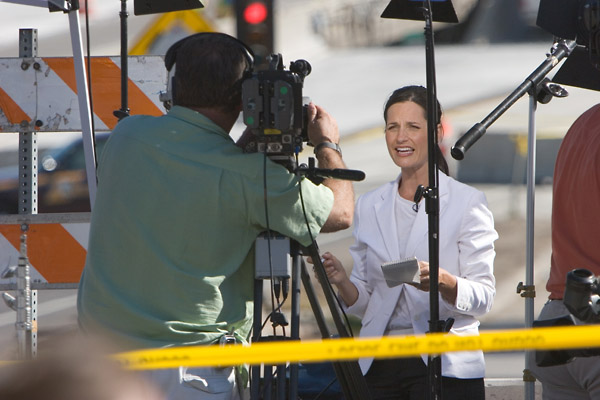
In a time where one is connected to the world through an object small enough to fit into the palm of his or her hand; where audience experiences are just as (if not more) important as the information they acquire; and citizens armed with smartphones over firearms are overthrowing governments; it comes as no surprise that broadcast journalism has transformed since the year we once referred to as “Y2K” or the “Millennium Bug” year (a bug more representative of a global computer malfunction that threatened to shut down everything from cash registers to power stations than a roach in the kitchen). Not only did we survive, but our media has completely transformed into a ever-evolving, amalgamated, and fluid entity that is no longer necessarily seen as one primary medium between governments, corporations and “the people” or “audience.” Here’s a list of five of the most noteworthy ways this has happened.
Citizen Journalism/Crowdsourcing
Social networking platforms have completely changed the media landscape for not only the journalists, but also the audience. Having access to the world from your personal account has made way for audience members to become a part of the information being put out into the World Wide Web. This, of course, means that news sources are now not just those who are experts in the topic at hand but regular citizens who may have been at the scene of the news and uploaded footage from their smartphone to Facebook or Twitter. Provided the original footage is identified and vetted, it can be a great source for broadcast journalists and the use of these amateur videos, images and personal accounts are now very commonly used in their news stories.
Social Networking
The use of social networking platforms aren’t just a means for citizen journalists or simply for journalists to use second-hand footage from them, but are now a significant part of journalists’ roles. In an era where news is now instantaneous and ubiquitous, news that is only broadcast during the show’s timeslot is almost obsolete. Journalists are now communicating news around the clock via Tweets or status updates to generate interest in their on-air broadcasts as well as using the responses and feedback to shape their stories. Networks are also making sure to broadcast their shows via numerous social networking platforms during and after on-air segments and simultaneously incorporating social media feeds into their on-air shows. And social media also provides a great means to measure viewer impact.
Multimedia/Multi-talented Journalists
With the Internet, came immediate access to information. And with smart technology, came ubiquitous information that blurred the lines between producer and consumer. Consequently, print media suffered financially and broadcast information became prevalent and multifaceted. This meant that journalists needed to adapt to many new technologies and avenues without an equal amount of staff to help them. More often than not, they are required to pitch stories, go out and shoot them, edit them and present them whilst simultaneously using their social media to generate interest and discussion for them online. So getting in touch with all facets of delivering news stories like camerawork and editing programs will be a huge plus if you’re looking to get hired in broadcast news today.
Podcasts
What was once a broadcast news show tailored for a target audience at a specific time slot in a specific location is now tailored to reach a much wider audience without limitations on time. As previously mentioned, the consumer or audience member has now also become the producer and actor—having the ability to access and produce information in their own time without having to wait for it—as seen with podcasts. Radio news can now be downloaded at the user’s convenience and companies like NPR that have taken advantage of such a portal are now at the forefront of their industry. On that note, what used to be the acronym for National Public Radio is now just known as NPR, due to the idea of “radio” being quite archaic for many people—a clear example of how companies are changing and adapting to the new milieu.
YouTube
In 2011 and early 2012, five out of fifteen months from YouTube’s most searched term of the month was a news related item. In the seven days following footage of the Japanese earthquake and tsunami in March 2011, the twenty most viewed news-related videos on the site all focused on the tragedy and were viewed more than 96 million times. This new kind of television news has made companies like Vice News a force to be reckoned with. What originally began as a niche print magazine (Vice Magazine) then expanded to Vice Media, consisting of divisions including a website, film production company, record label and publishing imprint. Vice News became the company’s current affairs brand and their daily content consists of articles on their website and videos on YouTube. Vice News provides documentaries and original news series but the Vice Media brand has diversified through the platform with multiple channels categorised into subgroups like food (Munchies), music (Noisey), or technology & science (Motherboard). The main Vice YouTube channel alone (not inclusive of their sub-group channels) gets an average of 26 million views per month with an estimated yearly earning of $1.2 million. A true exemplar of heterogeneity, Vice Media are now looking to release a new cable channel in 2016 that’s being programmed in conjunction with A&E Networks called Viceland, as well as a nightly news program called Nightly Vice, expected to debut on HBO later that year.
In summary, it all comes down to these three words—Convergence, Diversification, and Connectivity. News is no longer linear and broadcast technology no longer falls under two categories. For broadcast journalists and the news industry as a whole to flourish in this transformed news landscape, embracing and adopting these three things are imperative.
[su_note]Learn more about the School of Broadcast Journalism at the New York Film Academy by clicking here.[/su_note]